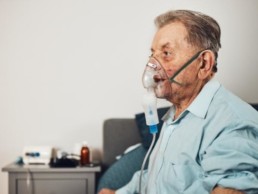Recognizing Our Veterans This Mesothelioma Awareness Day
This September 26th marked the 17-year anniversary of Mesothelioma Awareness Day. This is a day devoted to spreading awareness about this rare and extremely aggressive form of cancer. What many do not know is that mesothelioma is one of the few non-genetic forms of cancer and is usually spoken in tandem with asbestos. Asbestos is the only known culprit of mesothelioma and was heavily used throughout the military from the early 1900s up until the 1980s. Unfortunately, its past use in the military has led to emerging mesothelioma cases today, with roughly 900 new mesothelioma diagnoses annually among our veteran population.
Exposure In The Air Force
For veterans of the Air Force, exposure to asbestos most likely happened on actual Air Force bases. Insulation, wall board, piping, plumbing, sealers, and adhesives were known to contain this carcinogen. Servicemen and women most at risk of exposure were the ones who lived on these bases with their families.
Planes used by the Air Force also contained asbestos in some parts, such as the heat shield, engine, and brake pads. Aircraft mechanics were put at risk as these parts began to wear down and fibers were released into the air. Secondhand exposure was also a risk, as asbestos fibers cling to the clothes. This means that mechanics could have been carrying asbestos off the job site, unknowingly exposing their families when they came home from work for the day.
Exposure In The Coast Guard
Those who served in the Coast Guard were mostly likely to come into contact with asbestos while on shipyards and on ships. Coast Guard Cutters were likely to be harboring asbestos in many different areas of the ship. Pump rooms, boiler rooms, sleeping quarters, and mess halls all could have had asbestos-containing materials (ACMs) present. The close quarters type of living on these vessels allowed for asbestos fibers to travel easily to other areas of the ship, potentially exposing everyone on board. The height of exposure for Coast Guard personnel was during World War II, where usage and production of asbestos was at its peak.
Exposure In The Army
Similar to the Air Force, Army personnel had a high risk of exposure when on Army bases. Insulation, floor tiles, roofing, and cement incorporated this carcinogenic mineral not only because of its fire-resistant qualities, but because it was so cheap. Off-site locations known as Army reserves were also prone to the usage of asbestos. In 2005, the Environmental Protection Agency (EPA) reported that there were still ACMs that needed to be abated from these locations.
Army vehicles also utilized asbestos in some parts that would experience high temperatures and friction. This posed a risk to Army mechanics whose job required them to repair brake pads, gaskets, and clutch plates on vehicles used in combat and transport.
Exposure In The Navy
Navy veterans are the most likely of all military personnel to develop an asbestos-related disease. This is due to the fact that asbestos was most heavily used among this branch of the military. Cruisers, destroyers, aircraft carriers, submarines, and more were often built with ACMs. Asbestos was primarily used in the insulation of these vessels and was also favored because it does not deteriorate easily when in contact with water. The servicemen and women involved in the building, repairing, and retiring of these ships were the ones who most likely were exposed, as the ACMs would degrade overtime.
Exposure In The Marines
Much like the Navy and Coast Guard, veterans of the Marines were also put at risk by being on and working with ships. Marines are often aboard Navy ships being transported to and from conflict areas. While being transported, they carry out maintenance tasks the same as any Navy member would. These duties may involve repairing gaskets or removing insulation, which can disturb and release asbestos. Unfortunately, many of the high-risk ships used throughout World War II and the Vietnam War are still a part of the Navy’s fleet today.
Spreading Awareness
With mesothelioma continuing to affect so many veterans every year, the Purple Heart Foundation believes it is imperative to increase awareness of this disease. This cancer could be diagnosed less, or even disappear, if we are vigilant in protecting ourselves and our military population from asbestos exposure.
Social Security Benefits & Veterans
How to Qualify for Social Security Disability Benefits the Same Time as VA Benefits
If you are a veteran who is disabled, you may qualify for both Veterans Administration (VA) benefits and Social Security Disability Insurance (SSDI) administered through the Social Security Administration (SSA). While both are disability programs administered by government agencies, both programs have very different criteria that must be met for an applicant to be approved for benefits. You can qualify for both VA benefits and SSDI if you meet the specific criteria established for both programs.
You can have pending applications with both agencies at the same time, or you might be approved for one program and awaiting approval for the other. VA benefits are provided for disabilities related to your military service only, and you don’t have to be totally disabled. Your VA benefits are based on the severity of your service-related disability and the compensation rating it receives.
Because there aren’t financial requirements that must be met to receive VA benefits, you can receive VA benefits along with another form of disability benefits at the same time. To receive SSDI, you must have worked enough to earn adequate credits – usually this is the equivalent of 5 years full-time out of the last 10 years. You must be completely disabled for at least a year, or have a condition expected to result in death. All your medical issues are considered together – regardless of whether they are related to your military service or not.
The Disability Approval Process
The VA will review your medical records associated with your military service. If you get approved for VA benefits first, it will not necessarily help your SSDI claim. At one time, getting a high compensability rating from the VA, such as 70 percent or more, would lead to additional consideration. The new regulations published by the SSA in 2017 indicate that the SSA will not take VA benefit approvals into consideration for an SSDI application, but the SSA will review any evidence the VA considered when making their decision. The SSA will use Department of Defense (DOD) or VA evidence to expedite SSDI claims for veterans who are Wounded Warriors or who have a 100% compensability rating through the VA.
The VA doesn’t give special deference to an approval for SSDI, the VA Is required by law to consider the records that the SSA had to review regarding your condition. The medical records reviewed by the SSA could prove beneficial by offering key evidence that might help the VA render a favorable decision for your claim. While you could have a lower compensability rating – such as 5% or 10% through the VA – you could be declared fully disabled by the SSA. The SSA will consider your service-related disability, such as a back problem or lung disease, and they will also consider medical problems not associated with your military service, such as arthritis, cancer, diabetes, and heart problems.
The Application Process
If you have applied for VA benefits, you should also apply for SSD. SSDI benefits are based on the claimant’s work history – so your eligibility also relies on the credits you have earned from working. In most instances, you must have worked 5 years full-time out of the last 10 years. If you wait too long, you will start losing credits and you will become ineligible for SSDI. The application process for Social Security disability benefits is fairly straightforward. You have the option of applying online on the SSA’s website or you can do so in person at a Social Security office. After you send in your application, you should hear back from the SSA regarding your claim within three to five months.
Resources Found Via:
- https://www.va.gov/
- https://www.ssa.gov/disability/
- https://www.ssa.gov/
- https://www.disabilitybenefitscenter.org/glossary/social-security-disability-work-credit
- https://www.disabilitybenefitscenter.org/blog/disability-benefits-warrior-transition-unit-program
- https://www.ssa.gov/applyfordisability/
- https://secure.ssa.gov/ICON/main.jsp


